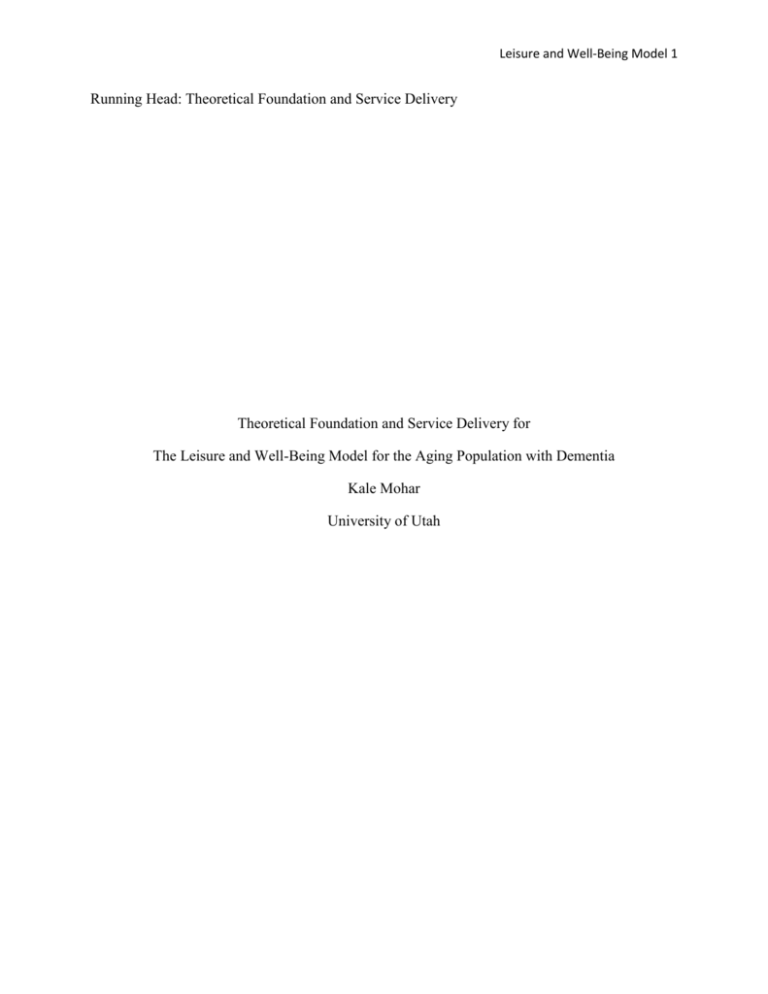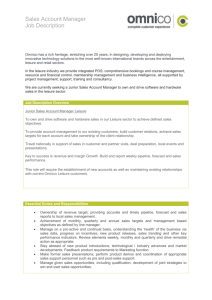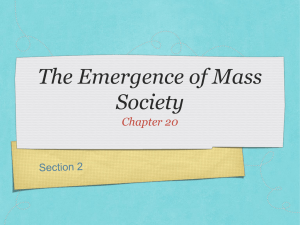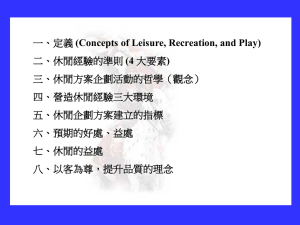Theoretical Underpinning of The Leisure and Well
advertisement

Leisure and Well-Being Model 1 Running Head: Theoretical Foundation and Service Delivery Theoretical Foundation and Service Delivery for The Leisure and Well-Being Model for the Aging Population with Dementia Kale Mohar University of Utah Leisure and Well-Being Model 2 Theoretical Foundation and Service Delivery Focusing on people’s strengths and abilities instead of their weaknesses and disabilities allows for an overall increase in positive affect, emotion, and experience. These overall increases in positive affect, emotion, and experience make it possible for a heightened state of well-being. In this paper, I will define The Leisure and Well-Being Model and explore the possibility of application to the aging population with dementia. The Leisure and Well-Being Model The Leisure and Well-Being Model is founded in strength-based practices, psychology, human development, and leisure behavior theory. The Leisure and Well-Being Model has two main components of service delivery that are also considered the proximal outcomes; enhancing leisure experience and developing resources, capacities, and assets. The ultimate goal or distal outcome of The Leisure and Well-Being Model is an overall sense and increase of one’s wellbeing. Well-Being is a state of successful, satisfying, and productive engagement with one’s life and the realization of one’s full physical, cognitive, and social-emotional potential (Pollard & Rosenberg, 2003). When providing psycho-educational interventions that aid resource developments there are five broad categories that are interconnected: psychological resources, social resources, cognitive resources, physical resources, and environmental resources. The psychological resources in the Leisure and Well-Being Model that are central to well-being are capacity for happiness, emotion regulation, self-awareness, self-determination competence, optimism, and sense of meaning. Leisure can be used, within the psychological category, to help develop selfawareness, give one’s life meaning, and help cope with negative life events. Social resources, such as relationships to one another, are important for happiness and strength; positive Leisure and Well-Being Model 3 relationships are associated with positive emotions. Social resources include things as communication skills, interpersonal skills, reciprocal relationship skills, and social confidence (Iso-Ahola & Park, 1996). Cognitive resources help individuals learn and process information in order to experience a sense of personal agency, help with the ability to concentrate, remember information, set goals, follow directions, and solve problems (Lahey, 2001). Physical resources, such as physical health, fitness, mobility, energy, and vitality are important to overall well-being. Environmental resources are those that are outside of the individual. These resources include social connectedness and social networks, community engagement and empowerment. The Leisure and Well-Being Model not only focuses on leisure experiences, but the quality of those leisure experiences. Savoring leisure, authentic leisure, leisure gratifications, mindful leisure, and virtuous leisure are five ways to help and insure to have enhancing leisure experiences. Savoring leisure is being able to increase one’s attention to the positive emotions associated with leisure (Seligman, 2002). Authentic leisure is taking ownership of emotions, needs, wants, preferences, or beliefs (Harter, 2002). Leisure gratification happens when an individual not only feels happy, but feel that their lives have served some important purpose. Mindful leisure means to be aware of current leisure experiences as well as disengagement from concerns about daily life, the past, or the future. Virtuous Leisure is based on using ones’ strengths to contribute to something larger than oneself. Theoretical Underpinning of The Leisure and Well-Being Model There are two main theories that support the benefits of The Leisure and Well-Being Model. The leisure theory suggests and focuses on perceived freedom, perceived competence, intrinsic motivation, and positive affect. An individual being able to choose what leisure and recreation activities to participate in are essential in many areas of The Leisure and Well-Being Leisure and Well-Being Model 4 Model. A part of this decision is positive affect and intrinsic motivations. The positive psychology theory focuses on human capacities and strengths rather than on weaknesses, limitations, and disabilities. Focusing on one’s strengths can further improve their individual lives by developing a stronger sense of social agency. The Leisure and Well-Being Model with Aging Population/Dementia Individuals affected by dementia can have impairments to the five domains; psychological, social, cognitive, physical, and environmental. All of these are addressed and are focused on in The Leisure and Well-Being Model. During the assessment part of the TR process, it is important to find out from the individual or close acquaintance previous leisure activities or experiences that they enjoyed or encountered. This allows a plan to be developed that involves past interest and strengths, and therefore, individuals can experience desired leisure that falls into one or more of the areas mentioned before. The Leisure and Well-Being Model and The Programmatic Approach When planning for individuals with dementia, it may be difficult to plan and promote savoring leisure, authentic leisure, leisure gratifications, mindful leisure, and virtuous leisure due to intellectual disabilities. However, it is still possible to include psychological, social, cognitive, physical, and environmental resources which then lead to an improvement quality of life and promotes well-being as designed by The Leisure and Well-Being Model. An example is putting into practice “simple pleasures”. Individuals with dementia can experience pleasurable engagement through activities that can be associated to a past feeling or emotion. These simple pleasures can included, but not limited to listening to music, playing simple games, petting animals, eating certain foods, experiencing nature, accomplishing a task, and interacting with and helping others. Leisure and Well-Being Model 5 Conclusion The Leisure and Well-Being Model designed for therapeutic recreation programs can play an important role in designing a program for the individuals who are experiencing dementia by focusing on strengths rather than limitations. Dementia affects the same targeted area for developing resources in The Leisure and Well-Being Model; psychological, social, cognitive, physical, and environmental. Individuals coping with dementia can experience well-being through a program that focuses on enhancing leisure experiences to the best ability and developing resources. Leisure and Well-Being Model 6 References Harter, S. (2002) Authenticity. In C.R. Snyder & S.J. Lopez (Eds.), Handbook of positive psychology (pp. 382). New York: Oxford University Press. Iso-Ahola, S.E., & Park, C. J. (1996) Leisure-related social support and self-determination as buffers of stress-illness relationship. Journal of Leisure Research, 28, 169-187. Lahey, M. (2001). Cognitive rehabilitation. In D. Austin & M. Crawford (Eds.), Therapeutic recreation: An introduction (pp. 220-231) (3rd ed.) Boston, MA: Allyn & Bacon. Pollard, E. & Rosenberg, M. (2003) In M. Bornstein & L. Davidson (Eds.), Well-being: positive development across the life course (pp. 12-32). Mahwah, NJ: L. Erlbaum. Seligman, M. E. P. (2002) Authentic happiness. New York: Free Press.






